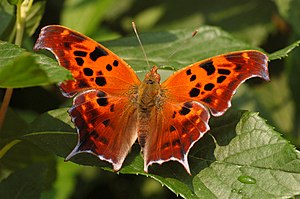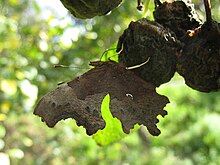Polygonia
| Polygonia | ||||||||||
|---|---|---|---|---|---|---|---|---|---|---|

Polygonia interrogationis |
||||||||||
| Systematics | ||||||||||
|
||||||||||
| Scientific name | ||||||||||
| Polygonia | ||||||||||
| Huebner , 1819 |
Polygonia (from the Greek πολύς - polys , "much" and γωνία - gōnia , "angle") is a genus of butterflies ( butterflies ) from the family of noble butterflies (Nymphalidae), whichoccurs inthe Holoarctic .
features
The moths have strongly serrated wings, which is what gave the genus its name. The tops are light brown to orange in color and have dark spots. The undersides of the hind wings are marbled in brown and beige tones, which camouflages them very well when the wings are closed. On the rear wing there is a white hook-shaped or angular sign, from which the C-butterfly, which occurs in Central Europe, gets its name. The hibernating generation often has a slightly different color than the non-hibernating generation. B. P. g-argenteum .
Way of life
The caterpillars mostly feed on species of the earlier order Urticales with the families of the elm family (Ulmaceae), hemp family (Cannabaceae), mulberry family (Moraceae) and nettle family (Urticaceae). The nettle family eats all but the closely related species P. progne , P. haroldii , P. gracilis , P. oreas and P. zephyrus , which are partly derived from the heather family (Ericaceae), birch trees (Betula) and currants (Ribes). feed.
The moths have a lively character, hovering dangling between the bushes of the forest fringes or in clearings, resting with outspread wings on leaves or the ground and sucking moisture or flowing sap from wonderful trees. Most species overwinter as moths.
Systematics
The genus originated in the Palearctic, about 18 to 19 million years ago. There were probably two nearctic settlements. The common ancestor likely fed on Urticales, as many species still specialize in these plants. Some have expanded their food spectrum, some now eat completely different plants.
The sister genera are the monotypical Kaniska with Kaniska canace , Aglais and Nymphalis with 6 species each. Sometimes Kaniska , Aglais, and Polygonia are considered subgenus of Nymphalis , as all species are closely related.
The type species of the genus is P. c-aureum . She is the sister of the lineage with all other species. P. egea and P. undina are very closely related and probably separated 8 to 13 million years ago, they form the sister clade to P. gigantea . P. undina was raised from subspecies to species status only after a DNA analysis , as it is clearly differentiated from P. egea and no hybridization is known. Together with the clade of P. c-album , P. interposita and P. faunus form these types of Palaearctic the Schwesterklade to the kinds of the Nearctic , wherein P. interposita prior to DNA analysis as a subspecies of P. c-album was seen . The Nearctic species P. comma and P. g-argenteum are closely related and probably only separated 2 to 3 million years ago. The DNA analysis of P. satyrus reveals a partly contradicting picture, which points to introgression with the ancestor of the clade from P. gracilis , P. zephyrus and P. haroldii . The DNA analyzes also showed that P. oreas is not a subspecies of P. progne , but a species of its own. P. zephyrus and P. gracilis are very closely related, the species status is not certain, as there is a broad zone with hybrids in western Canada that cannot be assigned to one or the other species.
- C-Falter Polygonia c-album ( Linnaeus , 1758) - Europe, North Africa and Asia to Japan
- Polygonia c-aureum ( Linnaeus , 1758) - East Asia
- Polygonia comma ( Harris , 1842) - United States and Canada
- Southern C-butterfly ( Polygonia egea ) ( Cramer , 1775) - Southern Europe to Afghanistan
- Polygonia faunus ( Edwards, WH , 1862) - United States and Canada
- Polygonia g-argenteum Doubleday & Hewitson , 1846 - Mexico
- Polygonia gigantea ( Leech , 1883) - China
-
Polygonia gracilis ( Grote & Robinson , 1867) - United States and Canada
- Polygonia gracilis zephyrus ( Edwards, WH , 1870) - United States and Canada
- Polygonia haroldii Dewitz , 1877 - Mexico
- Polygonia interposita ( Staudinger , 1881) - Asia
- Polygonia interrogationis ( Fabricius , 1798) - Mexico, United States, and Canada
- Polygonia oreas ( Edwards, WH , 1869) - United States and Canada
- Polygonia progne ( Cramer , 1775) - United States and Canada
- Polygonia satyrus ( Edwards, WH , 1869) - United States and Canada
- Polygonia undina ( Grum-Grschimailo , 1890) - Asia
Synonyms
- Eugonia Huebner 1819
- Comma Rennie 1832
- Grapta Kirby 1837
literature
- The Palaearctic butterflies . In: Adalbert Seitz (ed.): The large butterflies of the earth . tape 1 . Alfred Kernen, Stuttgart 1909, p. 206 .
- VK Tuzov, PV Bogdanov, SV Churkin, AV Dantchenko, AL Devyatkin, VS Murzin, GD Samodurov, AB Zhdanko: Guide to the Butterflies of Russia and adjacent territories . Libytheidae, Danaidae, Nymphalidae, Riodinidae, Lycaenidae. tape 2 . Pensoft, Sofia 2000, ISBN 954-642-095-6 .
- Scott, James A .: The butterflies of North America . Stanford University Press, Stanford, California 1986, ISBN 0-8047-1205-0 .
Individual evidence
- ↑ a b c Seitz, p. 206
- ↑ a b c d Niklas Wahlberg, Elisabet Weingartner, Andrew D. Warren & Sören Nylin: Timing major conflict between mitochondrial and nuclear genes in species relationships of Polygonia butterflies (Nymphalidae: Nymphalini) . In: BioMed (Ed.): BMC Evolutionary Biology . tape 9 , no. 92 . BioMed Central Ltd., 2009, doi : 10.1186 / 1471-2148-9-92 (English, biomedcentral.com [accessed January 5, 2014]).
- ↑ Elisabet Weingartner, Niklas Wahlberg & Sören Nylin: Dynamics of host plant use and species diversity in Polygonia butterflies (Nymphalidae) . In: European Society For Evolutionary Biology (Ed.): Journal of Evolution Biology . 2005, doi : 10.1111 / j.1420-9101.2005.01009.x (English, su.se [PDF; accessed on January 5, 2014]).
- ↑ a b c d Tuzov et al., P. 27
- ↑ a b c d e f g h Scott, p. 284 ff
- ^ Wahlberg, Niklas and Andrew VZ Brower. 2009. Polygonia Huebner 1819 . Anglewings. Version 04 June 2009 (under construction). in The Tree of Life Web Project, http://tolweb.org/
